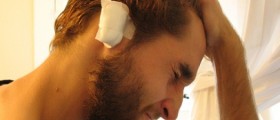
Ear infections are quite common. There are several types of them, related to the part of the ear they affect. Sometimes an ear infection only lasts a few days and then goes away completely, but sometimes it persists or comes back again soon after it was cured.
Chronic otitis media
Chronic otitis media is a chronic infection of the middle ear. The symptoms of this infection vary depending on the severity of the disease and on whether the mastoid bone is involved or the eardrum is ruptured. They can include pain, which can be quite intense, discharge from the ear, tinnitus or ringing in the ears, dizziness, malaise and fatigue, and sometimes, although rarely, facial weakness.
Some level of hearing loss can also be involved. Hearing loss may occur due to accumulation of fluid inside the middle ear or due to the fact that the eardrum is ruptured. Permanent hearing loss due to ear infections is not common and it is more likely to be associated with the damage or trauma to the small bony structures in the ear.
Chronic otitis media, which lasts for extended periods of time and does not respond well to conservative treatment with eardrops and antibiotics, is likely to involve a ruptured eardrum. If the eardrum does not heal by itself, a surgery may be required. Tympanoplasty is a surgical procedure that resolves the infection in the ear and closes the perforation in the eardrum. This is usually done in an out-patient procedure, using either local anesthetic or general anesthesia.
Sometimes a chronic and long-lasting otitis media spreads to the mastoid bone, in which case it is necessary to perform mastoidectomy along with the tympanoplasty. Mastoidectomy is basically a procedure of surgical removal of a severely damaged mastoid bone.
Cholesteatoma
Cholesteatoma is a problem that is sometimes associated with chronic ear infections. It is a cyst or a pouch that starts as a perforated eardrum and continues to grow, destroying the surrounding bone structure. Cholesteatoma is a serious medical issue and should never be left untreated. Bone damage can cause the infection to spread further, affecting the brain, the inner ear and the nerves that control facial muscles.
Cholesteatoma can rarely be cured without surgery. Doctors usually start treating it with oral antibiotics and eardrops, but if it does not respond soon, a surgery is most likely to be indicated. The surgery for removing cholesteatoma and for repairing the damaged ear structure is usually done under general anesthesia.

















Your thoughts on this
Loading...